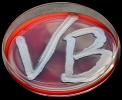| Species/Subspecies: | Anaplasma phagocytophilum | |||||||||||||||
|---|---|---|---|---|---|---|---|---|---|---|---|---|---|---|---|---|
| Category: | Zoonotic | |||||||||||||||
| Etymology: | Genus name: a thing without shape. Species epithet: is attracted by phagocytes. | |||||||||||||||
| Significance: | Most common during late spring, summer and autumn in Sweden. [Very important] |
|||||||||||||||
| Alternative Species Name(s): | Ehrlichia equi, Ehrlichia phagocytophila and the HGE-agent have been transferred to one species, Anaplasma phagocytophilum. | |||||||||||||||
| Taxonomy: | Class Alphaproteobacteria Order Rickettsiales Family Anaplasmataceae Genus Anaplasma |
|||||||||||||||
| Type Strain: | Webster | |||||||||||||||
| Macromorphology (smell): | Cannot be cultured in cell-free media (for instance agar plates). | |||||||||||||||
| Micromorphology:
| Small pleomorphic and non-motile cocci (0.3-0.4 µm in diameter). Blood smears ("buffy coat smears") are stained by Giemsa or acridine orange staining. The bacteria can then be seen in the granulocytes as small bluish-lilac or orange red, respectively, coccoid rods inside inclusions (so-called morulae). A morula (see below) can be up to 6 µm in diameter. | |||||||||||||||
| Gram +/Gram -: | G-. Gramfärgas dock normalt inte. | |||||||||||||||
| Metabolism: | Aerobic | |||||||||||||||
| Catalase/Oxidase: | ||||||||||||||||
| Fermentation of carbohydrates: | Is not used for identification of Anaplasma spp. because it may be difficult to differentiate the metabolism between the bacterium and the host cell. Furthermore, many intracellular bacteria lack enzymes for carbohydrate metabolism because of evolutionary gene reduction. | |||||||||||||||
| Spec. Char.: | ||||||||||||||||
| Special Media: | ||||||||||||||||
| Vector:
| The bacteria are transmitted by ticks (primarely Ixodes ricinus in Sweden) and are not contagious between individuals. | |||||||||||||||
| Reservoir: | Small rodents and wild ruminants etc. | |||||||||||||||
| Disease: |
|
|||||||||||||||
| Genome Sequence: |
|
|||||||||||||||
| 16S rRNA Seq.: |
| |||||||||||||||
| Taxonomy/phylogeny:
|
Seven species have been described within the genus Anaplasma, which is most closely related to the genus Ehrlichia. | |||||||||||||||
| Comment: | Intracellular, inclusions (morulae) in eosinofilic and neutrofilic granulocytes. Morula refers to the structure, which resembles mulberrys (Latin Morus, mulberry). Tetracyclines are used for treatment but the disease can heal without treatment. | |||||||||||||||
| Reference(s): | No. 5, 66, 80 | |||||||||||||||
| Updated: | 2026-01-07 |
